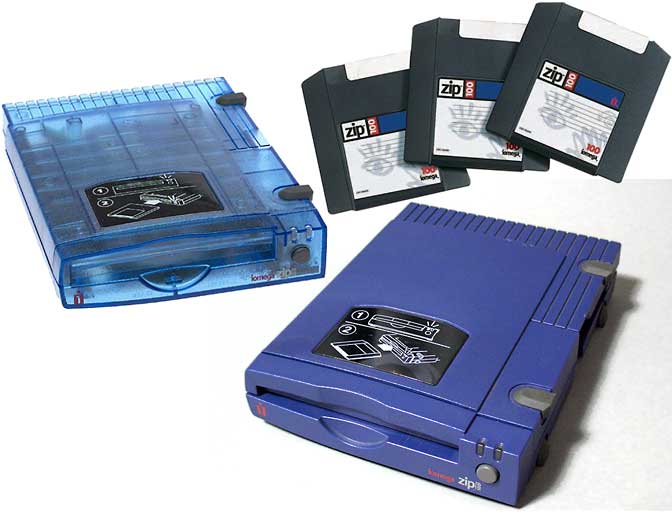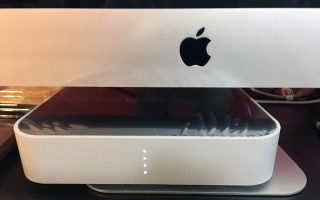Iomega, founded in 1980, was a big name in removable media drives starting with its original 5 and 10 MB Bernoulli Box in 1982. Instead of using hard platters, as SyQuest did, the high capacity Bernoulli system was essentially a big floppy disk that used the Bernoulli Principle to keep drive heads from actually touching the media. Clever stuff!
Bernoulli cartridges are huge, measuring roughly 210 x 275 mm (app. 8.3″ x 10.8″), relatively fast, and were a great way to move big projects between machines or work sites in the days before local networks and the Internet were uncommon.
The later Bernoulli Box II used a smaller cartridge, and the drive mechanism could fit in a standard half-height 5.25″ drive bay.
Zip

Iomega Zip 100 drives and disks.
Iomega is most famous for its Zip drive, introduced in late 1994. The disk was thicker and had a slightly larger footprint than a 3.5″ floppy drive, stored 100 MB of data on relatively affordable media, and provided decent throughput. I remember in those days having a 100 MB Zip disk set up with a full Mac OS install plus Norton Utilities and some other trouble-shooting apps. It was a very nice solution.
One popular use of Zip was with a Mac Plus because it let you run completely silent except during disk access.
Iomega later added 250 MB and 750 MB Zip drives and disks, followed by is Jaz drive, which used hard drive platters, provided higher throughput, and came in 1 GB and later 2 GB capacities.
As 100 MB became less useful over time, and because higher capacity Zip disks never caught on because they required new drive mechanisms, Iomega became a less and less important player in the storage industry. Adding a CD-RW drive to its line didn’t help since CD-RW was commonly being installed in PCs from the factory or easily added by tech types.
Iomega Hard Drives
That is the background, and in 2002 Iomega began selling external hard drives. However, Iomega was never a big player after the demise of Zip drives and disks, and the company was acquired by Lenovo in 2008.
The Iomega Mac Companion Hard Drive was actually a well-conceived product that should have had a broad market. The enclosure was designed to fit perfectly on the foot of the iMac (G5 models and later), sitting below the computer itself, and essentially using no desktop space since the iMac’s foot was already occupying that space.
WARNING: I have received feedback from one user who says that it is not bootable with a PowerPC Mac. The same drive mechanism worked just fine in another enclosure, so PowerPC users, beware.

Iomega Mac Companion Drive Enclosure
Styled in aluminum and black, it looks perfect with aluminum iMacs – except for one tiny detail that its designers didn’t take into consideration. While the enclosure fits beautifully on the iMac’s foot, it has one really stupid design flaw: When you connect the power supply and attach a cable to use it with USB 2.0, FireWire 400, or FireWire 800 (all cables are included with the drive, although the FireWire 800 connector is plastic and not a tight fit), it no longer fits on the iMac’s foot.
Yeah, you either have to move the drive forward or, if you’re using FireWire, you can slide it about 1″ to the left. Suddenly that beautiful design looks a bit awkward.
Odd Design, Great Deal
Fortunately, that inventory of unused Mac Companion cases was picked up by someone and is now available at a very reasonable $6.99 plus shipping on eBay. For an enclosure that works with a 3.5″ SATA hard drive and includes FireWire 800, FireWire 400, and USB support, that’s a steal. Needing a new backup system after my 3 TB Seagate drive died a couple years ago, I finally decided that this was the perfect time to start using Time Machine again.
In addition to the Mac Companion enclosures, I found a nice $49.99 deal on Amazon.com for a 2 TB* enterprise Hitachi Ultrastar HUA723020ALA640 2 TB, 64 MB buffer, 7200 RPM 3.5″ SATA 6.0 Gb/s hard drive. I bought two drives, and now have one Mac Companion Drive on my 2010 iMac, another on the 2008 iMac. Using Time Machine over my home network, my 2007 Mac mini and 2008 Aluminum MacBook can also be backed up to these drives. Not bad for a $130 investment, and I have a spare enclosure just because they were such a great deal.
Because the enclosure was never intended for sale without a drive installed, it doesn’t come with instructions for adding a hard drive. There is a wonderful step-by-step tutorial online, and after assembling the first one, the second one was a breeze.
Backup, Backup, Backup
I have a two-pronged backup strategy: I use SuperDuper! to create bootable mirror image backups of the partitions on my iMacs (Carbon Copy Cloner can do the same thing, but I have been a licensed SuperDuper! user for ages), so I create enough partitions, each of an appropriate size, on the Mac Companion and have bootable drives just in case the internal drive ever fails. And I have one additional partition that is used by Time Machine to store backups of each iMac as well as the MacBook. (Mac OS X 10.6 Snow Leopard doesn’t support multiple Time Machine destinations, so the Mac mini is only backed up to one of the two backup drives.)
One Odd Feature
This enclosure has one very unusual feature. You can only connect using FireWire 800 or USB 2.0, but never both (this is clearly spelled out in one online review). If you use USB, you can charge your iPhone or iPod. But if you use FireWire, there’s a USB port on the side that will provide the 2.1A needed to charge an iPad. It won’t process data, but it is a clever (and highly unusual) feature.
Conclusion
It works. It cost $7 plus shipping. It should work with higher capacity SATA hard drives, although any capacity limitations are not published anywhere. It is the cheapest FireWire 400 or FireWire 800 enclosure I know of. It works with good old USB 2.0 and provides three powered USB ports if you don’t use FireWire.
Oh, and it’s just $7 before shipping. The cables alone are worth the price. Ignore the fact that it doesn’t really fit on the iMac’s foot and makes you choose between USB 2.0 and FireWire 400/800. It’s a steal.
Add a reliable hard drive, and you have a great backup device. Get ’em while they last!!
* Some sources claim that the enclosure is only compatible with drives 2 TB or smaller, but Iomega made a 3 TB version, so higher capacity drives may work just fine. I played it safe and saved money by choosing a big enough drive at 2 TB.
keywords: #maccompanion #iomegamaccompanion #firewireharddrive #usbharddrive
short link: https://goo.gl/CV1brQ

